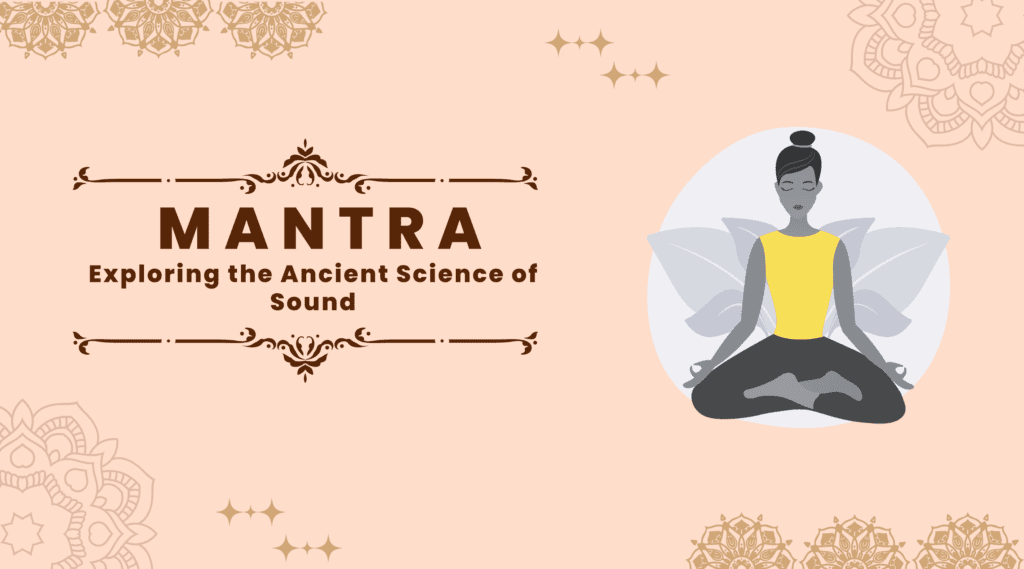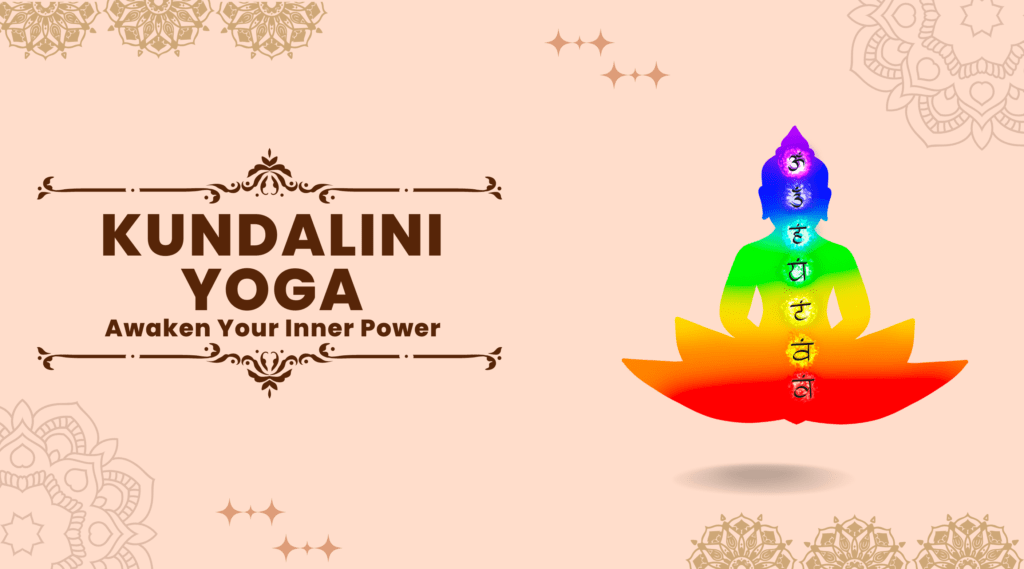Mantra: Exploring the Ancient Science of Sound

Introduction
In the hustle and bustle of our modern lives, it’s no wonder that we often find ourselves feeling overwhelmed, anxious or even disconnected. This happens generally because of the constant noise of daily challenges and distractions in our everyday life. And therefore when we seek solace and meaning, we find ancient practices that promise to illuminate our paths and bring clarity to our minds. One such timeless practice is the use of mantra – a sacred tool for achieving inner peace, fostering self-discovery as well as manifesting positive change.
In the realm of meditation and spirituality, we always encounter the term “mantra” frequently. So the question arises: what is a mantra?
Derived from the Sanskrit language, the word “mantra” combines the “manas” (mind) and “tra” (instrument), thus mantra means a tool for the mind. Mantras are a sacred word, phrase or sound. They carry specific vibrations as well as intentions.
Beyond a mere chant or repetition of words, a mantra holds deep significance as well as power within various spiritual traditions. Mantras serve as vehicles to focus and elevate the mind, leading to spiritual growth, inner transformation, and connection with the divine. In this article, we will try to understand the ancient science of sound and explore the mantras in detail.
History of Mantra
We can trace the history of mantras thousands of years back to ancient civilizations and spiritual traditions across the world. The origins of mantras can be found in Hinduism, Jainism, Buddhism, Sikhism as well as other indigenous cultures.
Hinduism
In Hinduism, mantras are an integral part of Vedic literature, which dates back to around 1500 BCE. The Vedas, the oldest sacred texts in Hinduism, contain hymns and chants that were recited by ancient sages during rituals and ceremonies. According to the texts, these vedic mantras have divine origins as well as they invoke the blessings of the gods. Also, they maintain cosmic order and achieve spiritual enlightenment.
Philosophical texts known as Upanishads, that followed the Vedas, introduced a more introspective approach to mantras. They emphasised the power of sound and its ability to connect the individual with the divine consciousness. Mantras from Upanishads are focused on self-realisation and the exploration of higher truths.
Buddhism
While in Buddhism, Mantras hold great significance. Particularly in Mahayana and Vajrayana tradition, they are viewed as sacred formulas that encapsulate the essence of enlightened beings, such as Avalokiteshvara (the Bodhisattva of Compassion) and Amitabha (the Buddha of Infinite Light).
Mantras are an essential part of meditation and spiritual practice in Buddhism. According to Buddhism, mantras purify the mind and develop the concentration while invoking the blessings and qualities of enlightened beings.
Jainism
Jainism is an ancient Indian religion that is known for non-violence and spiritual purity. According to Jainism, Jain mantras are a means of focusing the mind, cultivating virtues, and seeking spiritual liberation. Mantras purify the soul while aiding in the development of compassion, truthfulness as well as detachment from worldly attachments.
Sikhism
While in Sikhism, Mantras, known as “Gurbani,” hold a central place in the religion, a monotheistic religion founded in the 15th century by Guru Nanak Dev Ji. The Sikh scriptures, known as Guru Granth Sahib, contain hymns and prayers that are recited as mantras by Sikhs. According to the belief, these mantras are a direct connection to the divine. The devotees use them for meditation, devotion and seeking spiritual guidance.
Each tradition holds its own unique set of mantras, passed down through generations of spiritual seekers and practitioners. These mantras generally belong to the specific deities, enlightened beings, or spiritual principles, embodying the essence of the tradition they belong to.
Suggested: Best Yoga Retreats And Yoga Teacher Training In Rishikesh
The Power of Sound and Vibration
According to ancient wisdom, the universe is composed of vibrating energy. Every sound with its specific frequency carries a particular vibration that can affect our physical, mental, and spiritual well-being.
Thus mantras harness the power of sound and vibration. With their specific syllables and rhythms, mantras create a vibrational field that harmonises and aligns our energy with the higher states of consciousness.
Types of Mantras
Mantras can be categorised into different types based on their purpose and function as under:
1. Devotional Mantra: These mantras invoke and connect with specific deities or divine beings. They cultivate devotion, surrender as well as a sense of oneness with the divine presence.
2. Healing Mantra: These mantras focus on restoring balance, harmony as well as well-being at the physical, mental, and energetic levels. One can often chant or listen to for their therapeutic effects.
3. Seed Mantra: Seed mantras, also known as Bija mantras, are single-syllable sounds that hold profound symbolism and power. Examples include “Om,” “Aum,” and “Hum.” These mantras represent universal principles and activate specific energy centres or chakras within the body.
4. Affirmation Mantra: Affirmation mantras are positive statements or intentions that help reprogram the mind and cultivate a particular quality or state of being. They foster self-empowerment, confidence, and positive transformation.
Chanting and Meditation Practices using Mantra
Chanting mantras is a common practice in which the repetition of the sacred sounds helps focus and still the mind. Through rhythmic repetition, the mind becomes absorbed in the vibrations and transcends ordinary thoughts, which leads to a meditative state of awareness and connection with the divine.
Whereas, Meditation with mantras involves silently repeating the mantra internally, allowing it to become a point of focus for concentration. As the mind becomes attuned to the mantra’s resonance, it becomes a gateway to deeper states of consciousness and inner exploration.
Benefits of Mantra Practice
The Mantras offer numerous benefits if we maintain a regular practice of mantras. A few benefits are as under:
1. Mind Calming and Focus: Chanting mantras for meditation helps quiet the mind, alleviate stress, and improve concentration and mental clarity.
2. Spiritual Awakening: Mantra practice awakens the spiritual potential within, fostering a deeper connection with the divine, expanded consciousness, and self-realisation.
3. Energetic Alignment: Mantras activate and balance the subtle energy centres or chakras in the body, promoting vitality, balance, and overall well-being.
4. Emotional Balance: Mantras have the power to influence our emotions positively. They can help release negative emotions, promote inner peace, and cultivate positive qualities such as love, compassion, and gratitude.
Common Mantras
Hereunder are some common mantras that anyone can chant or listen to in everyday life:
1. “Om” or “Aum”
It is a seed mantra. Chanting “Om” or “Aum” can help create a sense of peace, unity and connection with the divine.
2. “Om Shanti”
This mantra translates to “Peace be upon you.” Chanting or silently repeating it can bring a sense of calm and tranquillity, especially during moments of stress.
3. Shiva Mantra: “Om Namah Shivaya”
This mantra belongs to the Lord Shiva and translates to “I bow to Shiva.” It invokes inner transformation, protection, and spiritual awakening.
4. Vishnu Mantra: “Om Namo Bhagavate Vasudevaya”
Which means I bow to the divine Lord Vasudeva (Lord Vishnu). By chanting or meditating upon this mantra with sincerity and reverence, individuals seek to deepen their connection with Lord Vishnu, attain spiritual growth
5. Guru Mantra: “Om Gurubhyo Namah”
It is a salutation to all Gurus (Teachers)
Conclusion
Mantras are not only words or sounds; but they are gateways to higher realms of consciousness and spiritual growth also. Rooted in ancient wisdom and spiritual traditions, they offer a profound tool for transformation, healing as well as connection with the divine.
Whether chanted, meditated upon, or listened to, the vibrations of mantras have the potential to awaken our true essence. They lead us on a transformative journey towards inner peace, self-discovery as well as spiritual awakening. Embracing mantras is not a call to abandon modernity or dismiss rationality; instead, it is an invitation to harmonise the ancient wisdom of the past with the realities of the present.
By integrating mantras into our daily lives, we cultivate a deeper connection with ourselves and the world around us, fostering mindfulness and a heightened awareness of the present moment. Embrace the power of mantras, and let their sacred vibrations guide you on the path of self-realisation and enlightenment.
You Can Also Read This:
2. Yoga Nidra



